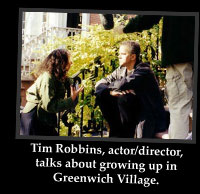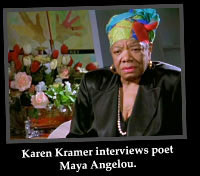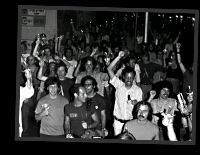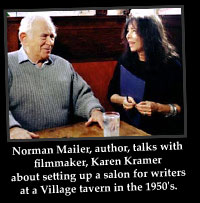| | 
The Ballad of Greenwich Village 2005, 70 mins. 
I first got the idea for doing a film about Greenwich Village back in 1992. I had already been living here for many years, when one day I was standing in line at a small store off Bleecker street and began chatting with the 87 year old woman in front of me. She had spent her entire life in the Village, and her stories about the people she had known here…unique characters, artists, famous writers…were wonderful. I began to think about all the artists and bohemians and intellectuals who had come to Greenwich Village from all over the country over so many decades, and it occurred to me that there were many of these stories that needed to be documented before it was too late. A little while later, a historic photo exhibit was shown at the Museum of the City of New York, portraying how Greenwich Village had been the capital of America’s bohemia as early as the mid-1800s. Although I had known, as many do, about the more recent history of the Village – the beats, the folk music, the jazz, etc. - I never realized how far back its influence stretched, how this area had been the continuous stronghold of those who question the status quo. As I did more research, I uncovered so many ideas, and art, and movements that came out of Greenwich Village which continue to reverberate. I was further amazed to learn that no one had ever made a documentary about the history of Greenwich Village.  My idea was that I would tell pieces of the history of the Village, and interweave it with the stories of people who are still living here and stories from famous personalities who had their creative roots in the Village. And although certainly no one film could cover all of it, my intention was to give a wide sweep that would give the viewer the breadth of accomplishments that occur when creative people have a venue, a haven where they can buck the mainstream. When I began, I never realized what an enormous undertaking this would be. Several assistants and I spent years tracking down the historic photos – a Herculean job. Many of the photos were exciting to find – a young Yul Brynner who played guitar at the Village Vanguard; a picture of poet Maya Angelou dancing to calypso at a Village club; a rarely-seen photo of the Village revolutionary John Reed visiting Russia that we obtained from the State Museum in St. Petersberg.  Getting interviews from the many well-known people who appear in the film was another challenge. First, I wrote each of them a detailed letter. Many of them were excited to talk about their days in Greenwich Village and they loved the idea of the project. BUT…....they all had very complicated schedules, and I had to wait until they could make time to come and sit before our camera. For example, I had to wait 16 months for Norman Mailer to be free, at which point he would only be available for filming during one week between Christmas and New Year’s. If I wanted to film the members of the Peter Paul & Mary trio it would have been easier to film them individually. But to get them all together, I had to wait a year until the 3 members were in the same location; nearly a year. After Woody Allen agreed to be in the film, we had to wait until he finished shooting and then editing his own film …ten months altogether. And so on. Whenever possible, I filmed the interviewee in a Village environment that he or she felt attached to. For example, in the 1950s Norman Mailer was part of a writers’ salon that met regularly at the White Horse Tavern on Hudson Street. The manager agreed to let us film the interview there, providing we were finished and packed up before the customers came in at 11. Edward Albee’s play The Zoo Story takes place on a park bench so we interviewed him on a bench in Washington Square Park. Folksinger Richie Havens sat with us at the Bitter End on Bleecker Street re-living the days when he performed there forty years earlier.  I also wanted to interweave into the film local people such as painters and political activists, as well as local establishments – such as The Village Vanguard (which influenced jazz history) and Chumley’s (which influenced literary history). Many of these places had been in the Village for so long, and I had passed them so often that I simply took them for granted; but in the ten years of being immersed in the making of the film, the people and the places took on a whole new resonance. As Tim Robbins, who grew up in the Village said in his interview with us “I was in the middle of this genius and these gems of personalities and these gems of creative individuals.
back to top | |